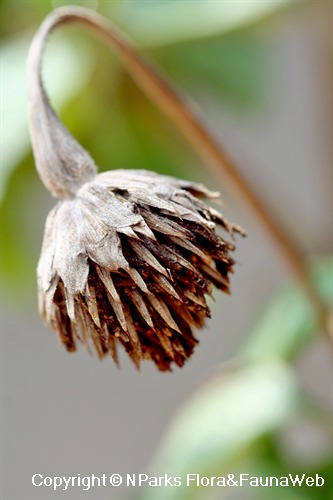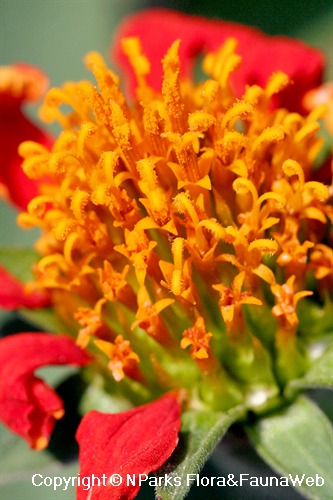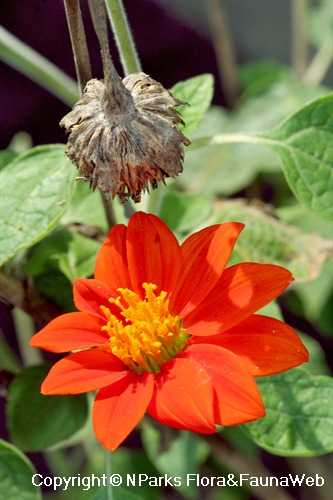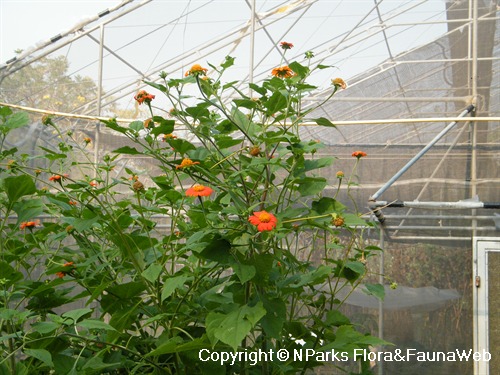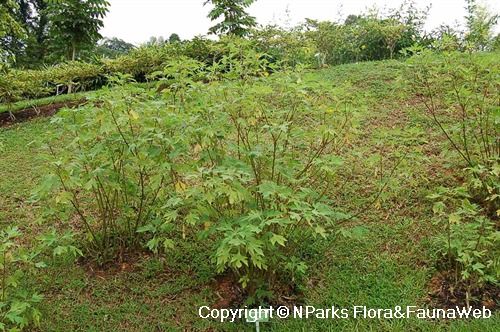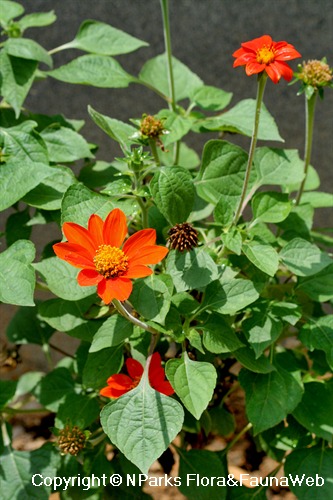
Back
Tithonia rotundifolia (Mill.) S. F. Blake
| Family Name: | Asteraceae (Compositae) |
| Synonyms: | Tagetes rotundifolia, Tithonia speciosa, Helianthus speciosus |
| Common Name: | Mexican Sunflower, Red Sunflower, Mexican Marigold, Goldflower of the Incas, 墨西哥向日葵 |
Name
Classifications and Characteristics
| Plant Division | Angiosperms (Flowering Seed Plants) (Dicotyledon) |
|---|---|
| Plant Growth Form | Herbaceous Plant |
| Lifespan (in Singapore) | Semi-Annual / Annual-Like, Annual |
| Mode of Nutrition | Autotrophic |
| Plant Shape | Shrubby |
| Maximum Height | 1.5 m to 2.0 m |
| Maximum Plant Spread / Crown Width | 0.9 m to 1.2 m |
Biogeography
| Native Distribution | Mexico, Belize, Costa Rica, El Salvador, Guatemala, Nicaragua, Panama |
|---|---|
| Native Habitat | Terrestrial (Grassland / Savannah/ Scrubland, Disturbed Area / Open Ground) |
| Preferred Climate Zone | Tropical |
Description and Ethnobotany
| Growth Form | Tall, stout and gangly-looking herbaceous shrub from Sunflower/ Daisy family (Asteraceae), grows as evergreen perennial in tropics and as summer annual elsewhere, up to 2m tall and 1.2m across. |
|---|---|
| Foliage | Leaves alternate, pubescent-green, with variable shapes (from broadly ovate to tri-lobed), crenate margins and decurrent purple-veined petioles (leaf stalk) that join to fuzzy stems. |
| Flowers | Clustered in upright capitulum heads (7cm across) on downy hollow peduncles (flower stalks), with numerous tiny yellow-orange fertile disk-florets fringed by a ring of petal-like sterile reddish-orange ray-florets. Aged inflorescences droop downwards. Relatively free-blooming under tropical conditions. |
| Fruit | Dry bristly achenes (1-seeded fruits), downward-facing and ripening from greenish to to tan-brown, containing up to 120 seeds per cluster. |
| Habitat | Occurring as weedy wildflower along roadsides, open ground and disturbed sites, often forming large colonies at moist spots. |
| Associated Fauna | Flowers very attractive to bees and nectar-seeking butterflies, especially the Sulphurs [eg. Catopsilia pomona pomona (Lemon Emigrant), Eurema hecabe contubernalis (Common Grass Yellow)], Skippers (eg. Celaenorrhinus leucocera (Common Spotted Flat)], and Lady butterflies (eg. Vanessa indica indica (Indian Red Admiral)]. |
| Cultivation | Vigorous, relatively low-maintenance and fairly easy to grow. Prefers full sun, but tolerant of slight shade. Withstands short droughts. Performs better in moist but well-drained infertile soils -- avoid overwatering, planting in waterlogged sites with heavy clay soils, or over-fertilizing which result in weak stems and excessive foliar growth at the expense of flowers. Allow suffcient room for growth of plants, stake stems to prevent uprooting by wind or heavy rain. Remove spent flowers regularly to encourage formation of more buds. Stressed plants prone to attack from insect pests like mealybug. Self-sowing, propagate by seeds -- which may take up to 3 months to germinate due to inherent dormancy. Seed-grown plants begin blooming at 2 months of age; plants grown as annuals in temperate zones complete life cycle within 4 months. |
| Etymology | Genus epithet 'Tithonia' named after Greek mythological figure, Tithonus -- legendary Trojan and lover to the Goddess of Dawn, Eos who asked Zeus to grant the Trojan immortality but forgot to also ask for eternal youth, upon which Tithonus grew increasingly old and weak, before turning into a cicada forever begging for an ultimately elusive death. Species epithet 'rotundifolia' means 'round-leaved', alluding to the shape of some of the plant's foliage. |
| Ethnobotanical Uses | Others: Fresh blooms ideal as beautiful cut flowers for vases, bouquets and floral arrangements -- use sharp knife and slice hollow stalks carefully to prevent them from bending and collapsing. |
Landscaping Features
| Desirable Plant Features | Ornamental Flowers |
|---|---|
| Landscape Uses | Flowerbed / Border, Hedge / Screening |
| Thematic Landscaping | Butterfly Garden, Naturalistic Garden |
Fauna, Pollination and Dispersal
| Fauna Pollination Dispersal Associated Fauna | Butterfly-Attracting |
|---|---|
| Pollination Method(s) | Biotic (Fauna) (Insects (Butterfly, Moth)) |
Plant Care and Propagation
| Light Preference | Full Sun |
|---|---|
| Water Preference | Moderate Water |
| Plant Growth Rate | Fast |
| Rootzone Tolerance | Easy to Grow, Drought Tolerant, Well-Drained Soils, Poor Infertile Soils, Disease / Pest Resistant |
| Maintenance Requirements | Moderate |
| Propagation Method | Seed |
Foliar
| Foliage Retention | Evergreen |
|---|---|
| Mature Foliage Colour(s) | Green |
| Mature Foliage Texture(s) | Velvety / Furry / Tomentose, Raised / Sunken Veins |
| Foliar Type | Simple / Unifoliate |
| Foliar Arrangement Along Stem | Alternate |
| Foliar Shape(s) | Non-Palm Foliage (Ovate, Deltoid) |
| Foliar Venation | Pinnate / Net |
| Foliar Margin | Serrate / Toothed, Crenate |
| Foliar Apex - Tip | Acuminate |
| Foliar Base | Cuneate |
| Typical Foliar Area | Notophyll ( 20.25cm2 - 45 cm2 ) |
Non - Foliar and Storage
| Stem Type & Modification | Herbaceous |
|---|---|
| Root Type | Underground (Fibrous Root) |
Floral (Angiosperm)
| Flower & Plant Sexuality | Bisexual Flowers |
| Flower Colour(s) | Orange |
|---|---|
| Inflorescence Type | Head / Capitulum |
| Flower Lifespan on Plant | Several Days |
| Flowering Habit | Monocarpic |
Fruit, Seed and Spore
| Mature Fruit Colour(s) | Brown |
|---|---|
| Fruit Classification | Simple Fruit |
| Fruit Type | Indehiscent Dry Fruit , Achene |
Image Repository
Others
| Master ID | 29439 |
|---|---|
| Species ID | 3748 |
| Flora Disclaimer | The information in this website has been compiled from reliable sources, such as reference works on medicinal plants. It is not a substitute for medical advice or treatment and NParks does not purport to provide any medical advice. Readers should always consult his/her physician before using or consuming a plant for medicinal purposes. |










